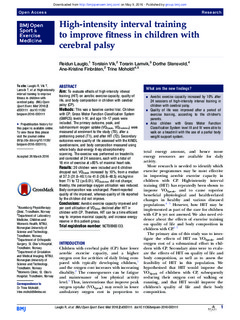High-intensity interval training to improve fitness in children with cerebral palsy
Lauglo, Reidun; Vik, Torstein; Lamvik, Torarin; Stensvold, Dorthe; Finbråten, Ane-Kristine; Moholdt, Trine Tegdan
Journal article, Peer reviewed
Permanent lenke
http://hdl.handle.net/11250/2392699Utgivelsesdato
2016Metadata
Vis full innførselSamlinger
Sammendrag
Aim To evaluate effects of high-intensity interval training (HIT) on aerobic exercise capacity, quality of life, and body composition in children with cerebral palsy (CP).
Methods This was a baseline control trial. Children with CP, Gross Motor Function Classification System (GMFCS) levels I–IV, and age 10–17 years were included. The primary outcome, peak, and submaximum oxygen uptake (VO2peak, VO2submax) were measured at enrolment to the study (T0), after a pretraining period (T1), and after HIT (T2). Secondary outcomes were quality of life assessed with the KINDL questionnaire, and body composition measured using whole body dual-energy X-ray absorptiometry scanning. The exercise was performed on treadmills and consisted of 24 sessions, each with a total of 16 min of exercise at >85% of maximal heart rate.
Results 20 children were included and 6 children dropped out. VO2peak increased by 10%, from a median of 37.3 (31.0–40.1) to 41.0 (36.6–48.5) mL/kg/min from T1 to T2 (p<0.01). VO2submax did not change; thereby, the percentage oxygen utilisation was reduced. Body composition was unchanged. Parent-reported quality of life improved, whereas quality of life reported by the children did not improve.
Conclusions Aerobic exercise capacity improved and per cent utilisation of VO2max declined after HIT in children with CP. Therefore, HIT can be a time efficient way to improve maximal capacity, and increase energy reserve in this patient group.
